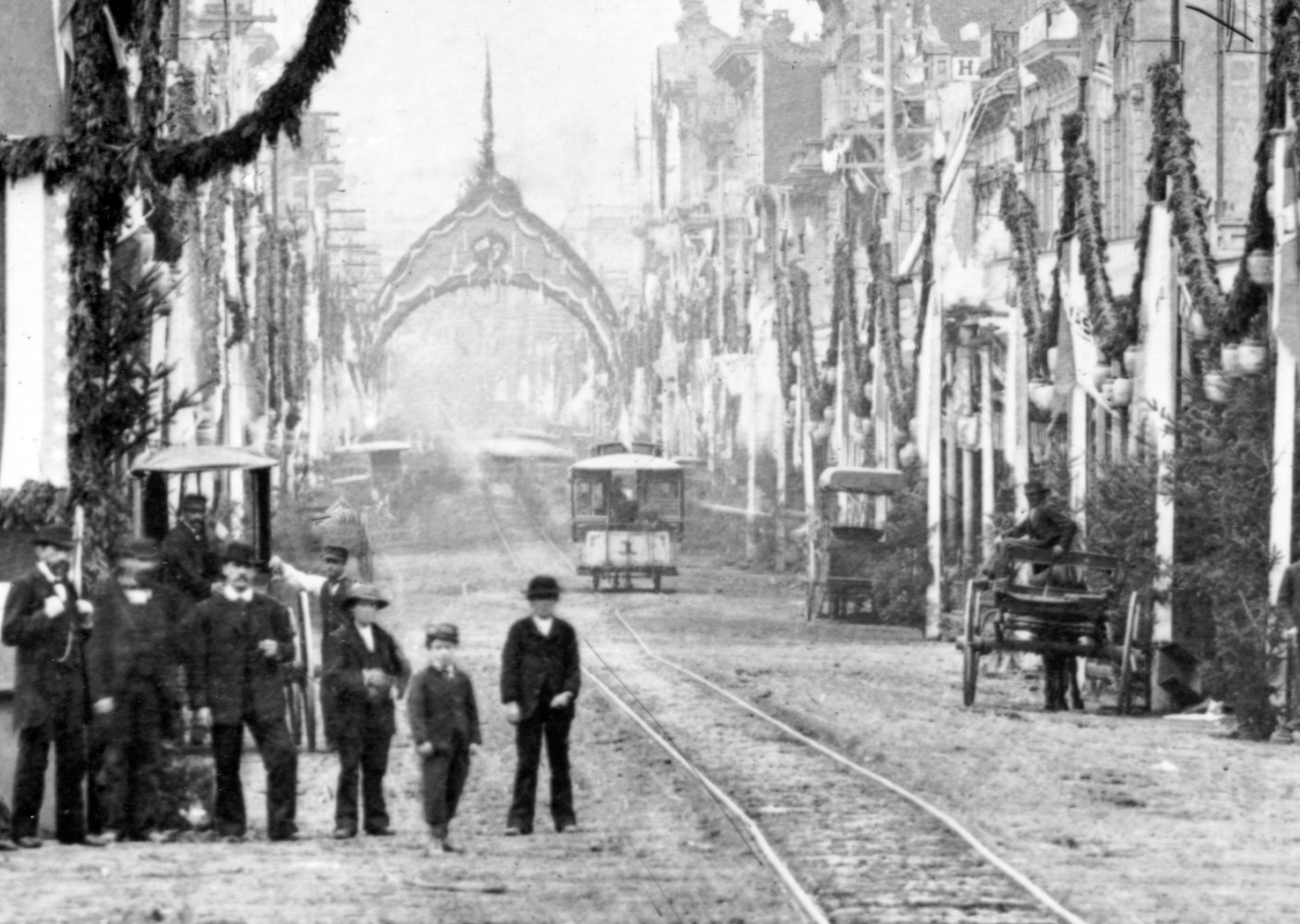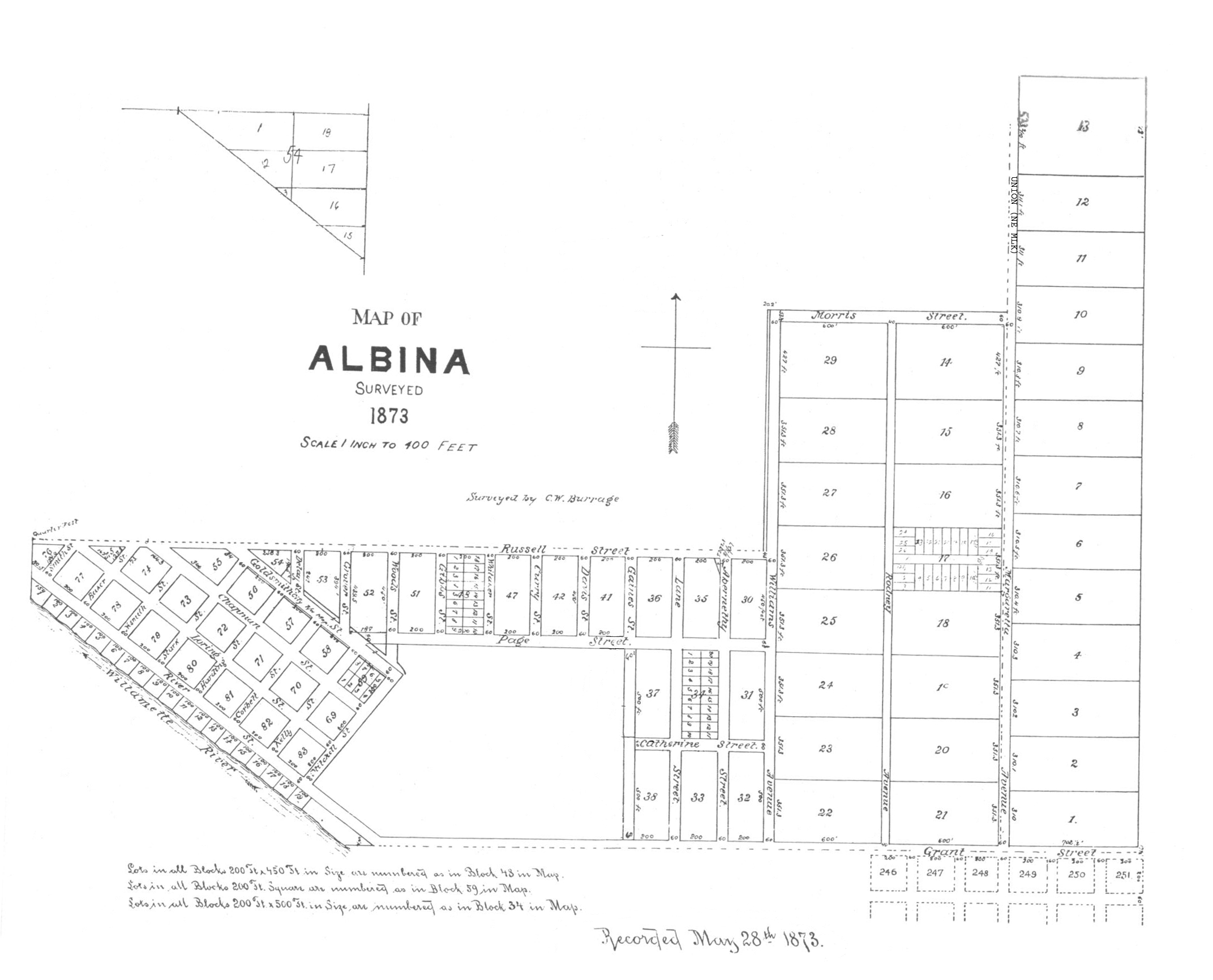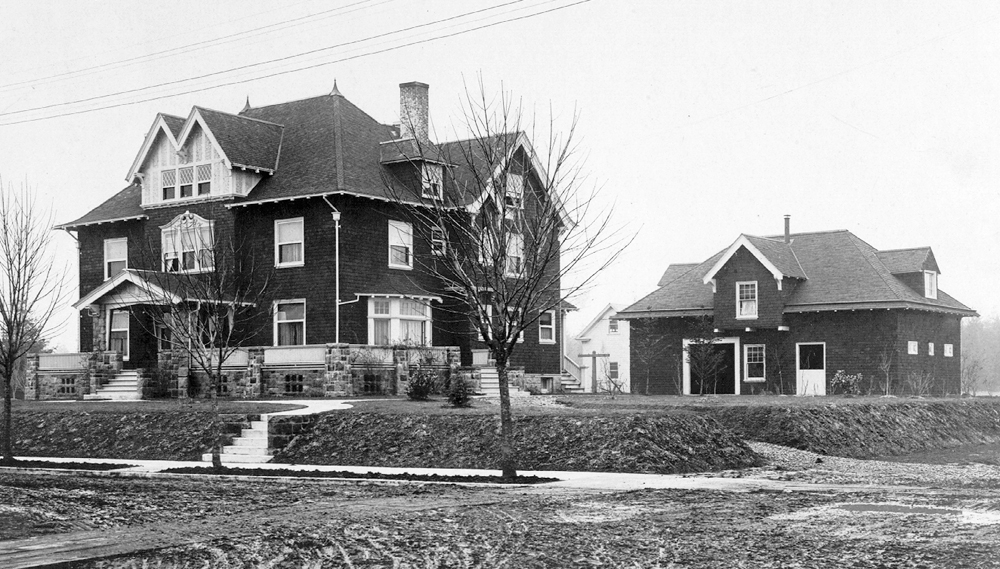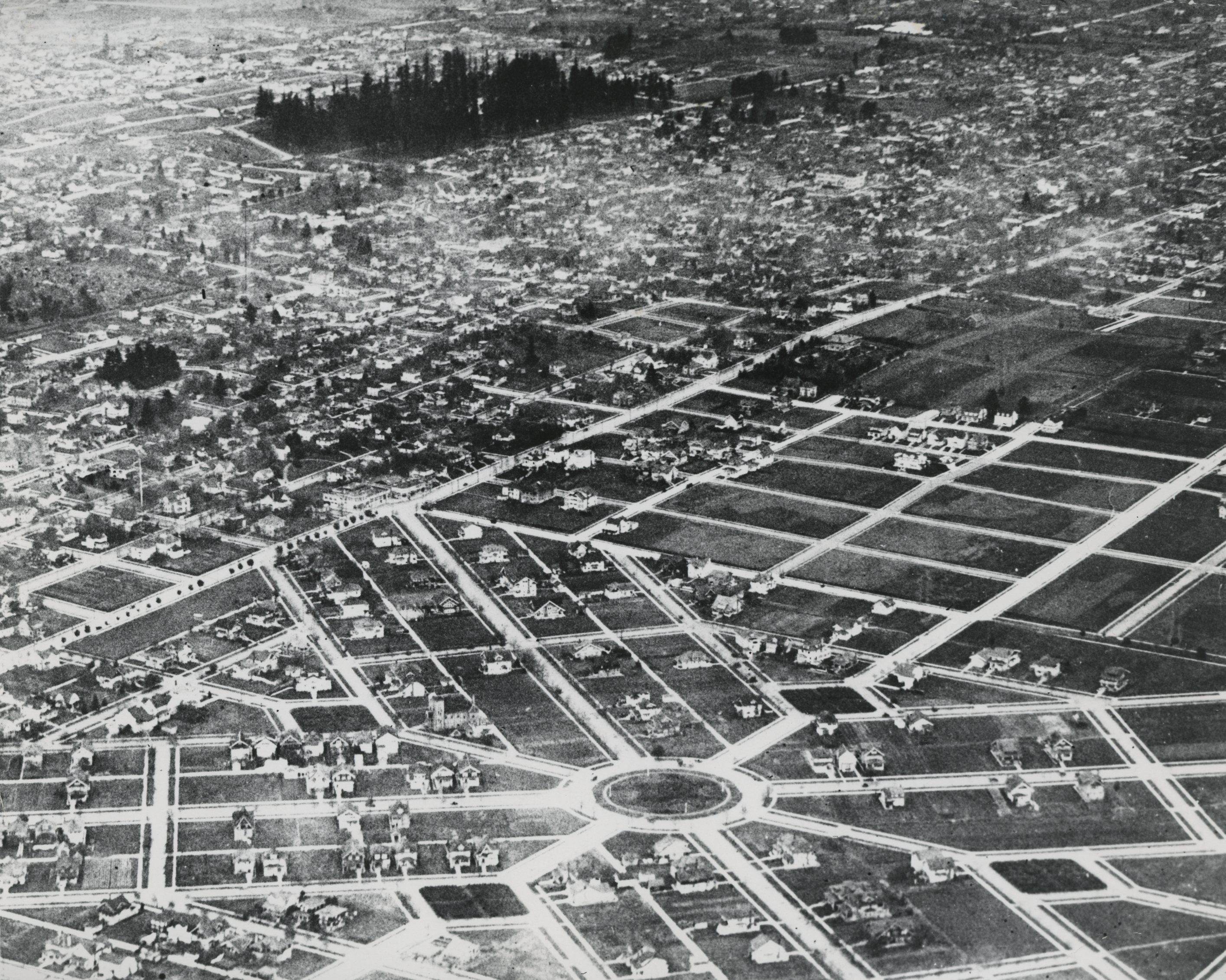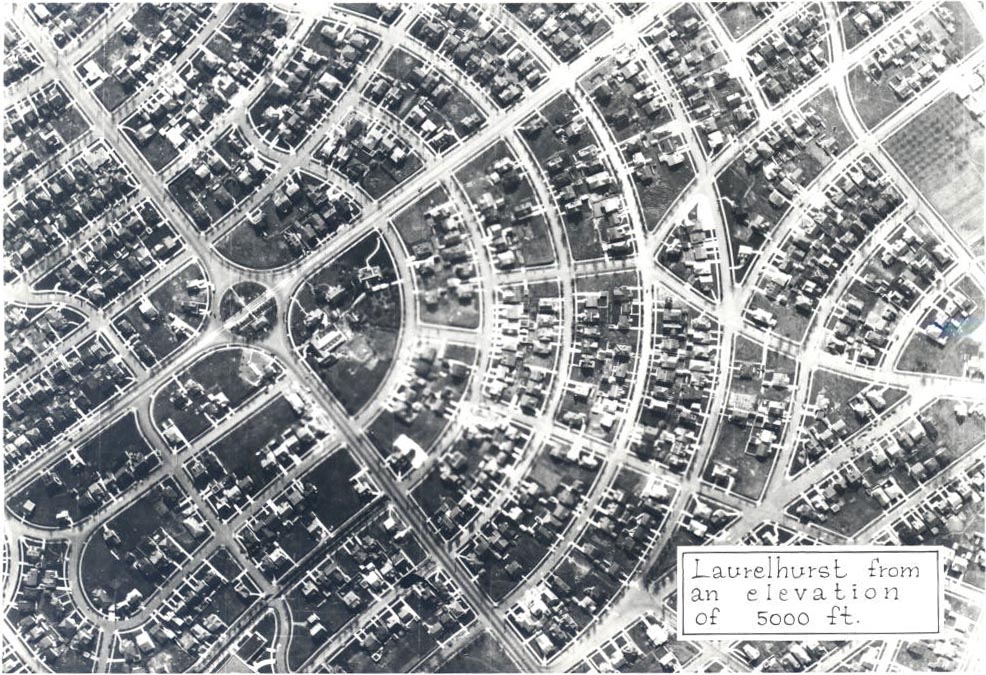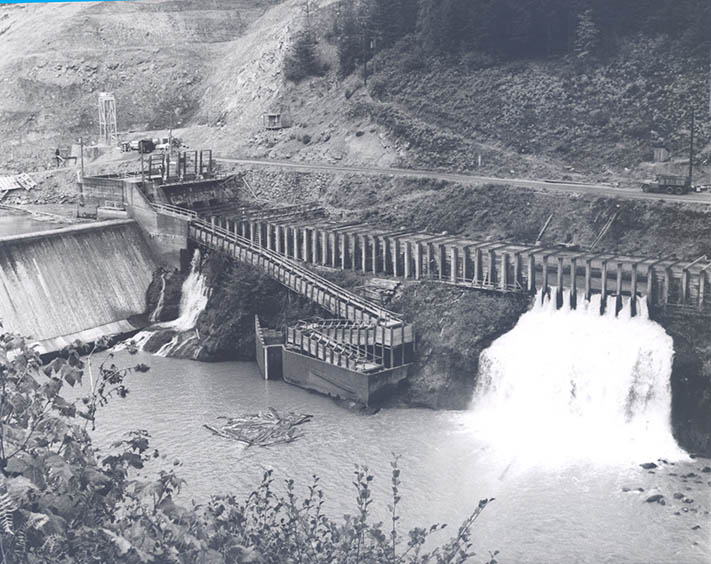The majority of Portland’s oldest neighborhoods owe their location and growth to the development of street railways. The pattern displayed on modern maps still reflects the pioneering streetcar lines radiating from downtown; Portland's Irvington Neighborhood is renowned for being an exemplar of a classic early twentieth century "streetcar suburb."
As the nineteenth century waned, Portland’s growing population walked to work and to shop. Although many dreamed of life in the more spacious and healthy environment offered in newer residential developments outside the city, the distance people could live from town was effectively limited to a mile or two.
Things began to change in 1872, when Ben Holladay built the city’s first streetcar line. The Portland Street Railway’s horse-drawn streetcars plied a two-mile route along 1st Street, from Northwest Glisan Street to Southwest Porter Street. By 1888, four more companies were operating horsecar lines in Portland, and another opened a line in East Portland and Albina. Portland’s horsecar companies, whose rolling stock was said to include the largest horsecar on the West Coast, laid the foundations for the nation’s third largest narrow gauge (42”) street railway system.
The length of the line soon exceeded the capability of horsecars. In 1887, the Willamette Bridge Railway Company built the first machine-powered transit in Portland. Their Mount Tabor Motor Line used trains of horsecars drawn by small locomotives disguised as streetcars. The designers believed that the "dummy" engines would be less frightening to passing horses and would avoid local restrictions against the use of locomotives in city streets. Within five years, a half dozen companies had joined the effort to provide steam “motor” service.
In 1890, the Portland Cable Railway added another technology in the form of cable cars built by the same company that provided them to San Francisco. Lines were built out Southwest Jefferson Street to City Park, to the waterfront on Southwest Alder, and up Southwest Chapman Street (now 18th Avenue) to Portland Heights. Passengers could now ascend the second steepest cable line in the country (with a grade of 20.93 percent).
The steam dummy and cable lines allowed people to live up to seven miles from their jobs. Although promoted as advanced technologies, however, both would be replaced by a form of power that would revolutionize the industry.
In November 1889, within a year of the completion of America’s first successful electric street railway system that drew power from overhead lines, in Richmond, Virginia, the first electric railway in Oregon began running across the Steel Bridge to Albina. During the next two years, most horsecar lines were converted to electricity.
Trolleys replaced the last steam line in 1903, and the remaining cable cars gave way to electricity the following year. Operating costs were half what they had been with horsecars, and streetcar lines extended into the countryside.
Trolleys began running between cities as well as to new streetcar suburbs such as Fulton Park, Willamette Heights, Rose City Park, and Mount Tabor. In 1893, the East Side Railway Company’s fifteen-mile line between Portland and Oregon City was the first interurban railway in the country. It was a revolutionary system, built and operated to steam railroad standards.
More than forty companies were involved in the development of Portland's city railways from 1872 to 1950, with a half-dozen fighting for patronage at the same time. This unwieldy structure was toppled by a combination of events in which the financial panic of 1893 played a significant role. As financial capital dried up, a number of companies faltered. Three remained after a series of consolidations; the City and Suburban Railway Company (C&S) operated the largest streetcar system in the Northwest; the Portland Railway Company embarked on an ambitious car-building scheme; and the Oregon Water Power and Railway Company took over the nation's first electric interurban railway.
In 1906, local streetcar companies came together to form the Portland Railway Light and Power Company (PRL&P). The Public Utility commissioner appraised the new company’s property at $18 million. Within ten years, PRL&P operated 40 lines over 300 miles of track with 583 streetcars.
By the time ridership peaked in 1922, street railways had become more than a means of transportation. During hot summer evenings, families relaxed in open cars; and on Sundays, people rode to the end of the line for a day of picnicking, hiking, or fishing. Trolley parks such as Council Crest and Oaks Park offered attractions including amusement rides, dance bands, and roller skating. People also rode streetcars to racetracks, golf courses, and beaches.
Affordable automobiles, better roads, and the rising cost of labor eventually changed all of that. By the late 1920s, people were increasingly envious of the freedom and status that came with owning an automobile. The last new streetcars, purchased in 1932, did not reverse the trend.
Rubber and fuel rationing during World War II briefly reinvigorated public transit, but the last three city streetcar lines were converted to bus operation in 1950 and the final interurban line ceased operating in 1958.
A generation would pass before Portland residents would rediscover the streetcar. Electric mass transit returned in three waves: in 1986, the first Tri-County Metropolitan Transportation District (Tri-met) light-rail line opened; between 1991 and 2014, Vintage Trolley operated reproduction Council Crest streetcars; and in 2001, the Portland Streetcar launched the first new streetcar line in America since World War II.
-
![Cable car in Portland, 1890s, near present-day SW 18th Ave. and Jefferson St.; bridge was 1,040 feet long and 270 feet high.]()
Portland, cable cars on incline, 1890s.
Cable car in Portland, 1890s, near present-day SW 18th Ave. and Jefferson St.; bridge was 1,040 feet long and 270 feet high. Courtesy Richard Thompson
-
![Excursionists on Springwater Division of Estacada Line, 1910s.]()
Open car excursion on Springwater Division.
Excursionists on Springwater Division of Estacada Line, 1910s. Courtesy Richard Thompson
-
![The Council Crest Amusement Park, which opened in 1907, was served by a trolley line that continued until 1950.]()
Portland, Council Crest Park.
The Council Crest Amusement Park, which opened in 1907, was served by a trolley line that continued until 1950. Courtesy Mark Moore
-
![Cars 804 and 805 passing on W. Burnside near 18th Ave. on the 23rd Ave. Line, 1940s.]()
Portland, streetcars on Burnside, 1940s.
Cars 804 and 805 passing on W. Burnside near 18th Ave. on the 23rd Ave. Line, 1940s. Courtesy Richard Thompson
-
![East Side Railway cars Bona and Kate passing on Main St. in Oregon City, 1890s.]()
Oregon City, East Side Railway cars, 1890s.
East Side Railway cars Bona and Kate passing on Main St. in Oregon City, 1890s. Courtesy Richard Thompson
-
![1904 map of Portland’s streetcar lines.]()
Portland, streetcar map, 1904.
1904 map of Portland’s streetcar lines. Published in Street Railway Journal, courtesy Richard Thompson
-
![Steam dummy motor No. 4 with coach No. 11 at east end of Mount Tabor Motor Line near present-day SE 69th Ave. and Belmont St., about 1890.]()
Portland, Mount Tabor Motor Line near 69th & Belmont.
Steam dummy motor No. 4 with coach No. 11 at east end of Mount Tabor Motor Line near present-day SE 69th Ave. and Belmont St., about 1890. Courtesy Mark Moore
-
![City and Suburban Railway headquarters about 1891, at present-day SW 3rd Ave. and Yamhill St.]()
Portland, painting of C & S railway ca 1891.
City and Suburban Railway headquarters about 1891, at present-day SW 3rd Ave. and Yamhill St. Dale Varner painting, courtesy Richard Thompson
-
![Council Crest electric streetcar, late 1940s.]()
Portland, trolley, elec., ba011752.
Council Crest electric streetcar, late 1940s. Oreg. Hist. Soc. Research Lib., ba011752
-
![Horse-drawn streetcars in Portland, about 1888.]()
Portland, trolley, horse, ba011754.
Horse-drawn streetcars in Portland, about 1888. Oreg. Hist. Soc. Research Lib., ba011754
-
![Horse-powered Car No. 1 of the Portland Street Railway, fall 1883.]()
Portland St Railway, horse streetcar.
Horse-powered Car No. 1 of the Portland Street Railway, fall 1883. Courtesy Richard Thompson
-
![Willamette Bridge Railway car No. 20, Nov. 1889.]()
Portland, first trolley, Nov 1889.
Willamette Bridge Railway car No. 20, Nov. 1889. Courtesy Richard Thompson
-
![Portland Traction Co. car No. 4017 being burned for scrap, spring 1959.]()
Portland, last interurban trains burning, 1959.
Portland Traction Co. car No. 4017 being burned for scrap, spring 1959. Courtesy Richard Thompson
-
![Car 808 and Council Crest Line car 506 meet at SW 2nd Ave. and Morrison St. on last day of service, Feb. 26, 1950.]()
Portland, last day for city streetcar, Feb 26 1950.
Car 808 and Council Crest Line car 506 meet at SW 2nd Ave. and Morrison St. on last day of service, Feb. 26, 1950. Courtesy Richard Thompson
-
![PRL&P car No. 566 during a layover on the Lower Albina Line on N. Mississippi Ave., 1910s.]()
Portland streetcar, 1910s.
PRL&P car No. 566 during a layover on the Lower Albina Line on N. Mississippi Ave., 1910s. Courtesy Richard Thompson
Related Entries
-
Albina area (Portland)
By the late 1880s, Albina, located across the Willamette River from Por…
-
Irvington neighborhood, Portland
The Irvington neighborhood in northeast Portland began as an exclusive …
-
![Ladd's Addition]()
Ladd's Addition
Ladd's Addition is a streetcar-era neighborhood in southeast Portland w…
-
![Laurelhurst]()
Laurelhurst
The Laurelhurst neighborhood in Portland is an historic twentieth-centu…
-
![Portland Railway Light and Power]()
Portland Railway Light and Power
Portland Railway Light & Power (PRLP) was created in 1906 through the c…
Related Historical Records
Map This on the Oregon History WayFinder
The Oregon History Wayfinder is an interactive map that identifies significant places, people, and events in Oregon history.
Further Reading
Labbe, John T. Fares Please! Those Portland Trolley Years. Caldwell, Id.: Caxton Printers, 1980.
Robley, Roy R. Portland Electric Power Company with its Predecessor and Subsidiary Companies 1860-1935. Portland, Ore.: Portland General Electric, 1935.
Thompson, Richard M. Portland's Interurban Railway. Charleston, SC: Arcadia Publishing, 2012
Thompson, Richard M. Portland’s Streetcar Lines. Charleston, S.C.: Arcadia Publishing, 2010.
Thompson, Richard M. Portland’s Streetcars. Charleston, S.C.: Arcadia Publishing, 2006.
Thompson, Richard M. Slabtown Streetcars. Charleston, SC: Arcadia Publishing, 2015.
Thompson, Richard M. Willamette Valley Railways. Charleston, S.C.: Arcadia Publishing, 2008.











